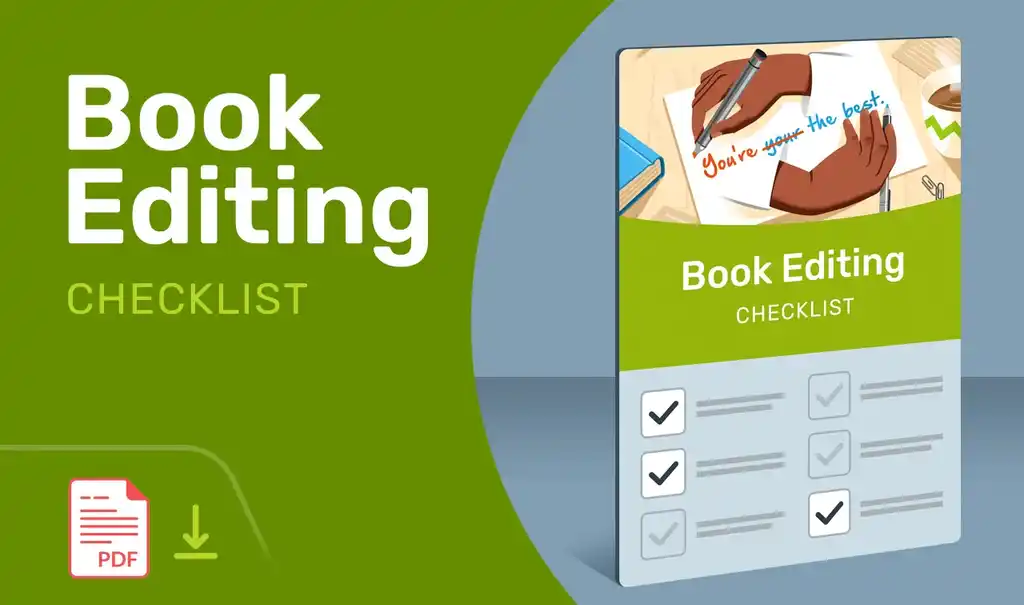Forget the myth that great writers produce their best work in strokes of unedited genius — the real art of writing lies in rewriting. No matter how strong your first draft is, the best books almost always emerge from many rounds of unglamorous, difficult rewriting.
Many writers resist these large-scale, interventionist edits, but the truth is that they’re an essential part of the process! Read on to learn 7 rewriting techniques to get the most out of your own revisions.
1. Take time away for objectivity
If you’re like a lot of authors, your first step after finishing a draft is to immediately read it through. That’s the best way to see how it’ll come off to your readers, right?
Wrong! It’s nearly impossible to be objective when your reading is informed by the highs and lows of writing. Instead of diving into revisions right away, take some time apart from your work before editing, so you can approach it with a fresh perspective.
🗄️ Try the “drawer method”
Stephen King, Zadie Smith, and others advocate for the “drawer method” — printing the manuscript out and putting it in a drawer for up to a year before even thinking about rewriting. This method allows writers to come to their edits more “organically” and stave off burnout.
If a year sounds too extreme (or if you’re on a deadline), try to take at least a month; even this amount of time can help you get into a “reader’s headspace.” You’ll be less sentimental about those scenes and sentences that don’t serve a purpose — and able to edit with focus and intention.
After you’ve put some time between yourself and your first draft, you can pull it out of the drawer (or Google Drive folder) and begin rewriting.
📝 Free Book Editing Checklist
Resolve every error, from plot holes to misplaced punctuation.
2. Start with structural edits
Don’t get mired in the little details when you set out to rewrite. Instead, start with big-picture revisions that change the shape of your story — what we might also call “developmental edits”.
There are two important reasons to start here:
-
You want to tackle any major edits at the start of this process, while you have sufficient energy; and
-
By fixing the “big stuff” first — plot, characters, and pacing — you avoid wasting time copy-editing sections you’re not even going to keep.
🕵️ Ask the hard-hitting questions
Before you even open your manuscript, ask yourself a few broad questions about your story:
-
What’s the main conflict?
-
What’s the protagonist’s biggest motivation?
-
What role does each supporting character play in the story?
As you read and begin to edit, make sure the story aligns with your answers. You can also use similar questions to evaluate the impact of each scene:
-
What does this scene accomplish?
-
What does it reveal about the characters or the setting?
-
What questions does it leave unanswered?
Don’t hesitate to reorganize the scenes in your story — and delete scenes where the purpose is unclear — until you get the pacing right.
Let’s move to the next tip for more on mastering those large-scale edits.
3. Write a reverse outline
Before starting your draft, you may have planned it out in an outline — a rough sketch of your story’s characters, setting, and plot.
Chances are, you didn’t stick to that plan exactly, and that’s okay! But to ensure that your story still has a coherent flow, now it’s time to create a reverse outline.
This is an outline that you put together after your draft is finished, not before, and that summarizes each part of the story. List out each scene in the order that it appears, summarizing in a sentence or two what happens and how it serves the broader plot.
🌀 Let it reveal superfluous elements
No need to go into excessive detail, but the reverse outline should include every scene in your book. If you think a scene doesn’t need to appear in the reverse outline, consider whether it needs to be in the book at all.
Similarly, if you can’t describe a scene’s purpose, you might need to rework it — or cut it out entirely. Since you followed tip #1 and took time away from your story (you did follow tip #1, didn’t you?), you shouldn’t struggle too much to get rid of scenes that don’t work.
But if you’d rather pare down your story one sentence at a time, the next tip might be a better fit for you.
4. Cut the fluff from your sentences
Kill your darlings. You’ve heard Arthur Quiller-Couch’s famous bit of editing advice before, but it bears repeating. We writers are often so proud of those eloquent sentences, snappy bits of dialogue, and florid descriptions that we don’t care whether they actually drive the story forward.
So I know this is tough, but give it a try: instead of asking whether a sentence sounds good, ask whether it belongs. Even the finest prose will drag your manuscript down if its sole purpose is to be pretty.
🧠 Remember, your readers are smart
Balance “show” and “tell” and don’t spell everything out. An attentive reader should know what your characters are feeling without lengthy explanation, and you can draw out expository details as they become relevant rather than all at once.
Cut down on unnecessary exposition and descriptions that could be borne out in action and dialogue, and keep an especially sharp eye out for adverbs, dialogue tags, and ineffective repetition in your fluff-culling edits.
If you struggle to see fluff on the page, the next tip is for you.
5. Read your work aloud
When reading your manuscript in your head, your wondrous human brain will unconsciously correct mistakes and smooth over clunky phrasings. Amazing, but it gets in the way of revision! Reading aloud forces you to slow down and pay attention to the rhythm of your writing.
It’ll also help you catch issues that don’t “stand out” on paper: awkward phrasing, repetitive sentence structures, and unconvincing dialogue. When reading aloud, pay attention to sentences that trip you up — if they’re hard to say, they’re probably hard to read, too.
🤖 Or use text-to-speech
If you’d rather save your breath, plug your manuscript into a text-to-speech program. Or if you have a really good friend — maybe an aspiring actor or politician — have them read it to you! Hearing your writing in someone else’s voice will help you see whether the emphasis, tone, and pacing come across as you intended, or if they’re only clear in your own mind.
For more on the benefits of having someone else read your work, let’s look at the next tip.
6. Share with an objective reader
Even after taking time away from the work and implementing structural edits with a reverse outline, most writers will still struggle to see their work from a reader’s point of view. In fact, the best way to get an outside reader’s point of view is by… sharing your draft with an outside reader!
Choose readers who won’t hesitate to deliver candid critical feedback — i.e., not your good friends or family who love you. You can find objective, knowledgeable beta readers in online writing groups, on reader platforms like Goodreads, or among people you know — especially fellow writers.
🤫 Solicit feedback anonymously
If you’re nervous about sharing unfinished work, use a pseudonym or find a platform that’ll let you share anonymously. Ask your readers for honest, thorough feedback. What pulled them in? What moments did they love, and which scenes didn’t work for them? Were they ever bored or confused?
Or for a professional perspective, consider paying for a manuscript evaluation. A good manuscript evaluator will know the market in your genre and offer actionable feedback that’ll make your book sell.
Once you’re confident in the shape of your book, it’s time to get into the nitty-gritty line edits.
7. Save line edits for last
Resist the urge to tweak every sentence early in the rewriting process. It’s important to get your phrasing right, but again, you’ll edit much more efficiently if you start with those big-picture changes.
So once you’ve dealt with big changes, go through your manuscript line by line to catch issues with your grammar, spelling, and syntax. Technology is your friend here: online grammar and spelling checkers will catch mistakes you might miss, especially after multiple rounds of revision. Still, it’s a good idea to manually review each edit to ensure it makes sense.
👀 Get a human to proof your final draft
For that final round of edits, consider hiring a proofreader. These professionals can catch complicated errors like improper citations, unnecessary passive voice, and run-on sentences that AI can still miss — leaving you with the best possible version of your manuscript.
Because rewriting isn’t just about fixing mistakes — it’s about elevating your story to its full potential. By approaching this essential stage of the writing process strategically, you can transform a rough draft into a clear, cohesive, and compelling manuscript.












Great breakdown actually, I mean you can't expect to have it perfect the first time! :)
Imran Siddiq - Over 11 years ago
Thanks Imran. Its only once you've finished version 1 that you can appreciate where to take the next version.
Brendanmc - Over 11 years ago
Well if I may be honest. I am the first type. I am the type to write a few pages, maybe even chapters and begin to revise them to perfection. Of course I have not even tried to touch on the rest of the story due to this method of writing and I often find myself exhausted by the time the revisions are done.. I'll try to hold my compulsion of correcting everything. Till I am finished with my first draft. :)
Christine Dargan - Over 11 years ago
Good plan Christine :). It is tough to change the behaviour (and we all want to excel), but banishing editing till the end ensures that you'll finish.
Brendanmc - Over 11 years ago
"Great article! I found the tips for rewriting sentences really helpful. It's amazing how a simple change in structure or word choice can completely change the clarity and impact of a sentence. The examples provided for each method were especially insightful. Read more techniques about Rewrite the sentence
Minki Star - About 2 years ago
Glad you found it useful!
Arja Salafranca - About 2 years ago